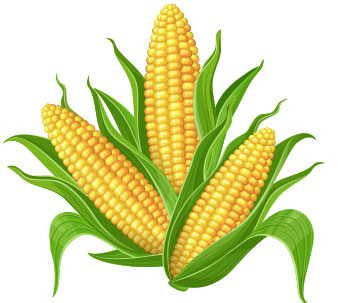
CornA Beginner's Guide
What is Corn? Definition
Maize, as it is known in much of the world, is a cereal grain in the grass family and is related to wheat, rye, rice, barley, and oats. Its large kernels are set in rows on the cobb. It produces many highly valued products for human and animal consumption and industrial applications. This page has everything you need to know about corn, including tips on how to grow your own!
Planting, Growing & Harvesting Corn
How to Plant Corn?
Corn should be grown in full sun. Well drained soils with a ph range of 5.8-7 work best but corn is very adaptable to many soil types as long as its nutrient needs are met. Proper soil temperature is critical to successful seed germination of corn.
Some treated seed can be planted when the soil temp is 55 degrees, but most should wait till 60 degrees and warmer. In early spring, cold wet weather can make a return, potentially rotting seed that has been planted.
How Deep to Plant Sweet Corn?
Early planting should be planted ¾- 1 inch deep. Plantings later in the season can be planted 1-2" deep.
This helps keep them in contact with moist soil as the soil warms and dries. To ensure thorough pollination of the ears, several short rows are better than one long row. For corn to be pollinated, pollen falls from the tassels at the top of the plant down on the silk on the ears of corn. The pollen is less likely to fully pollinate the ears with one long row since it could blow to one side or the other.
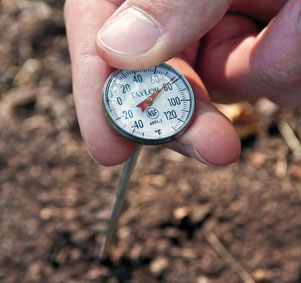 If you do not have a soil thermometer, many people use phenological cues from nature to plant various crops. It is said to start planting corn when apple blossoms begin to fall, when oak leaves are the size of squirrel ears or when dogwoods are in full bloom. Some instant read kitchen thermometers are good for this purpose.
If you do not have a soil thermometer, many people use phenological cues from nature to plant various crops. It is said to start planting corn when apple blossoms begin to fall, when oak leaves are the size of squirrel ears or when dogwoods are in full bloom. Some instant read kitchen thermometers are good for this purpose.
Isolating Plantings of Corn
When growing more than one variety, it may be necessary to isolate plantings to prevent cross pollination. Cross pollination between different types of corn can lead to starchy, tough corn. Isolation can be accomplished 2 ways. Time and distance.
Planting so the maturation time or harvesting time is two weeks apart is one way to isolate. Maturation time is often listed in the description, for example, Silver Queen is listed as 90 days. You could plant Bodacious (75 days) the same day you plant Silver Queen, and you would not have cross pollination problems. If planting two varieties with similar maturation time, stagger the planting time by 12-14 days
Isolating by distance is especially important for super sweet (sh2) varieties. They need to be separated from non-supersweets by 350 feet. If not isolated, pollen from other corn could ruin the harvest.
How to Grow Corn
Fertilizing
When possible, have your soil tested prior to the growing season. This will give you an accurate idea of soil fertility. Corn is a heavy feeder and especially likes extra nitrogen to help grow healthy and strong stalks. When corn stalks reach 5-6 inches tall, put a band of fertilizer on either side of the row and lightly hoe it into the soil. A second feeding can be done when the corn tassel is just starting to show. Gurney's sweet corn food is an excellent fertilizer to keep corn healthy and productive. Other blends can be used and make sure to look for blends with a higher nitrogen content than the other two major components phosphorous and potassium. These are necessary butnot as much as nitrogen.
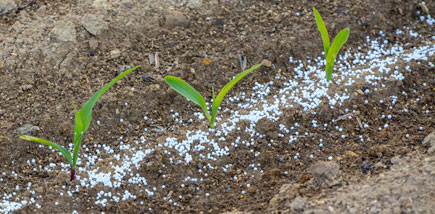
Weeding
As with any crop, keeping your corn patch weeded is a primary task. Weeds compete for water, nutrients and light. Entire crops can be lost if you allow weeds to overtake the crops. Several methods can help keep weeds at bay. Light hoeing or tilling between rows is a common practice and hand weeding directly around each plant. If available, mulch will drastically cut down on weeds since they won't be able to germinate in the first place. Mulch also helps retain moisture. And depending on what mulch you are using, it can add nutrients back to the soil for the corn to use. Grass clippings, mulched leaves, straw, cardboard or hay all work well.
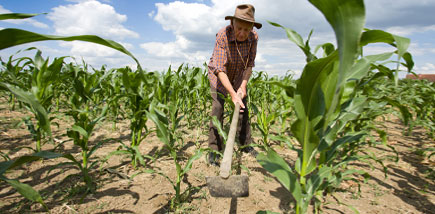
Watering
Corn has shallow roots so making sure it has ample water is important to a healthy productive crop. If rainfall is not producing enough water for corn to thrive, supplemental water will be needed. One inch a week is recommended. When corn is silking is an especially important time to supply water. Drought conditions can keep the ears from fully developing.
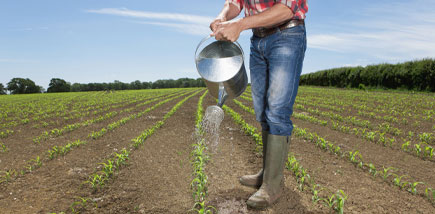
Types of Sweet Corn
The many types of sweet corn can be confusing. Se, su, sh2, what does it all mean. The guide below should help simplify the types.
-
Normal Sugary (su)

- Hearty corn flavor and firm creamy texture.
- Sugars convert to starch quickly. Eat ASAP
- Classic old varieties Isolate from (sh 2) varieties
- Superior tenderness, creamy texture and good corn flavor.
-
Sugary-Enhanced (se)
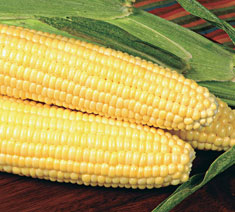
- Superior tenderness, creamy texture and good corn flavor.
- Higher sugar levels than (su) varieties. Holds quality longer in storage.
- Isolate from (sh 2) and (su)
-
Super sweet hybrids (sh2)
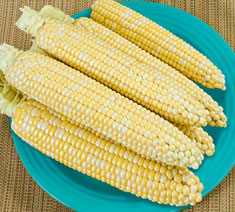
- Extra sweet flavor and crisp texture
- Higher sugar content
- Slower conversion of sugars to starches than su and se varieties. Stores more than a week.
- Isolate from (su), (se) and (sy) varieties
-
Augmented Super Sweet Hybrids
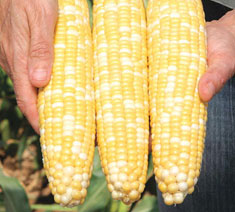
- All the benefits of sh2
- Plus, greater vigor and cool soil emergence
- Exceptional flavor and quality.
- Isolate from (su), (se) and (sy)
-
Synergistic Hybrids
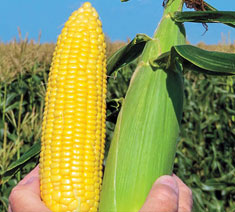
- Combines best characteristics of sh2 and se varieties.
- Very high sugar content, tender crisp texture
- Slow conversion of sugars to starch
- Isolate from (sh2) and (su) varieties
Harvesting
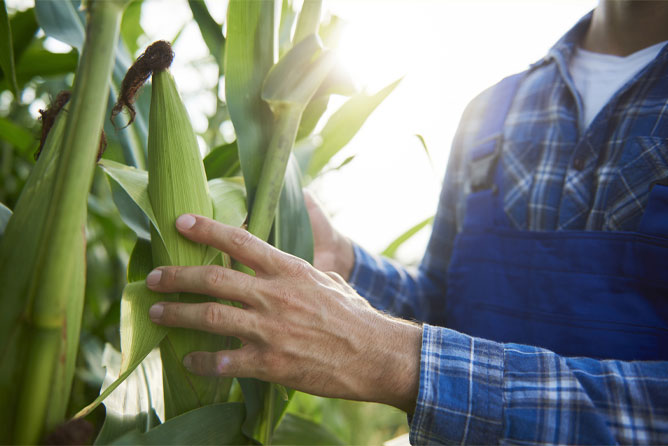
Corn is ready for harvest when silk is browning and drying. This is usually 18-25 days after silk first appears. You can also slightly pull some of the husk back from the tip to check how mature the kernels look. They should look full and be milky when squeezed. Refrigerate as soon as possible.
If you will have plenty of ears to spare, try harvesting some ears when they are still very small. The kernels will not be developed; however, you can eat the baby corn like you see in some Asian cuisines. They are crisp and crunchy with a saccharine sweetness raw. The sweetness mellows when cooked. It is worth a try to round out your corn growing experience. Ornamental and popcorn can be left on the plant until the husk and stalks dry.
Corn Pests and Diseases
Common Corn Pests
There are two major caterpillar pests that attach to corn. Corn Earworms and European Corn borer.
If you notice corn leaves breaking or irregular shot holes in newly emerging leaves, you may have European corn borers. Their eggs are often laid underneath leaves. After hatching they often feed in the whorl of newly emerging leaves at the top of the plant. Eventually they bore down into the stalk. Plants can be severely weakened and unproductive. Sometimes the stalk will break. Depending on where you live, borers emerge in late may-June. A second generation emerges later in the summer. European corn borers can be controlled prior to entering into the corn plant with BT sprays like Gurneys Green Step II Caterpillar control or a product that contains Spinosad.
Corn Earworms are the most noticeable pest since they feed inside the ear of corn. Anyone who has ever shucked an ear of corn to find an earworm feeding knows what a nuisance they are. The feeding on kernels and frass they leave behind is not the only issue. When they feed on kernels they eat through the silk. This makes it especially hard to remove the silk that is left behind.
Earworms are easy to control but require timely sprays directed at the silk of the corn ears. Our Green Step II Caterpillar control works great for this.
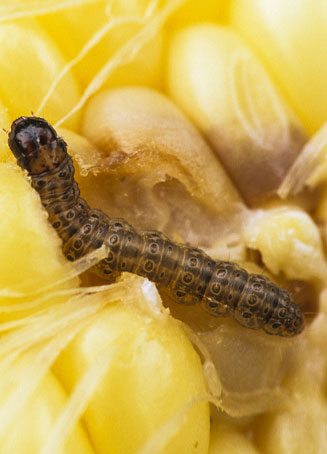 Corn Earworm
Corn Earworm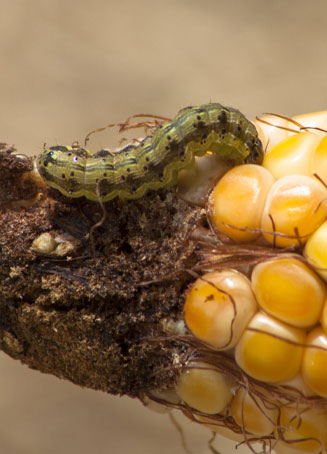 European Corn borer
European Corn borer
 Corn Smut
Corn Smut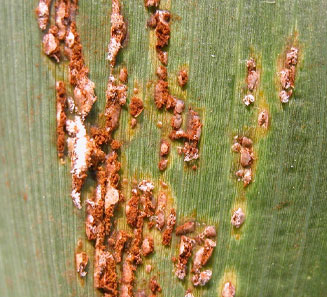 Common Rust
Common Rust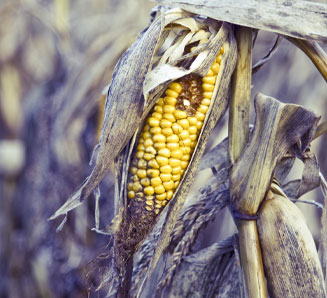 Southern corn leaf blight
Southern corn leaf blight Stewarts wilt
Stewarts wilt
Common Corn Diseases
Rarely do diseases ravage corn crops in the home garden. General garden sanitation helps with many of the disease. By preventing weeds in the patch and nearby areas plus removing crop debris will go a long way in preventing many diseases. Also, using high quality, treated seedand selecting varieties listed as resistant will help elevate some of these diseases.
The most noticeable disease that infects corn is corn smut. It is a freakish gray gall forming fungus that can infect all above ground portions of the corn plant. It is especially prevalent on the ears. When on the ears, it infects individual corn kernels and expands by many times the kernel size. Its appearance reminds me of expanding foam insulation going from light gray to an oozing black.
Don't be too freaked out, it does not infect your whole crop and is considered a delicacy in Mexico. It has a fungus flavor with hints of corn.
Common Rust is sometime seen in home gardens. Easy to diagnose, rust appears as small brick red raised areas on the upper leaf surface. Sprays are only effective if the disease is caught in its early stages. Soap-Shield Flowable liquid copper fungicide is a good spray option for the home grower.
Southern corn leaf blight can be recognized, it produces tan spots starting on the lower leaves and works its way up the plant. Spots can enlarge with time and cause severe blight. The cobb can also be infected. Good garden sanitation and rotating the yearly crop so it doesn't follow another grass helps.
Stewarts wilt can cause wilt and death in corn seedlings. Long rectangular spots can be seen on young and old leaves. The disease is transmitted to the corn by the corn flea beetle early in the seedling stage. Controling the flea beetles will provide control of the disease if you catch them soon enough. Pyola insect spray will kill the flea beetles.
Is Corn Good for you?
Fresh corn isn't just a summertime treat—it's a source of valuable nutrients. Among them are vitamin C, some of the B vitamins (such as thiamin and niacin), folic acid and magnesium. The insoluble fiber in corn helps provide good bacteria to maintain a healthy gut and keep bowels moving. The antioxidants zeaxanthin and lutein found in corn help promote eye health. Corn does contain some protein, but it's an incomplete protein because it lacks some essential amino acids. However, when you combine corn with other incomplete protein sources like beans, you increase the health benefits. And dishes with corn and beans are delicious.
A Brief Corn History
Domestication of maize started between 6,000 and 10,000 years ago from a grass called Teosinte. If you happened to be rambling around southern Mexico and ran into Teosinte, most likely your thoughts would not go instantly to corn. Teosinte only bears a slight resemblance to corn plants and the "ear of corn" it produces is not even vaguely reminiscent of today's varieties. Teosinte, a robust grass has ears %" long, with only 5-12 kernels. Each is covered by a hard shell. Modern maize has naked seeds with nearly 500 kernels.
Many types of corn evolved over time. Flint, dent, flour, popcorn and a few others were primarily used for human and animal feed. When modern agriculture took hold, the uses greatly expanded. Food industry and industrial applications lead to Maize production worldwide surpassing wheat and rice. Some of these products include corn starch, corn oil, ethanol, biofuels and corn sweeteners.
Along the way, indigenous North Americans noticed that some ears of maize were sweeter than others and started selecting for sweetness. They introduced these sweet corns to European explorers.
Important discoveries in the 1950's and 1960's led to great changes in sugar content and storability of sweet corn. The sh2 and se genes were discovered and breeding new varieties with these genes commenced. The se gene helped create sweater and more tender corn while sh2 produce very sweet corn with sugars that did not convert to starch, therefore allowing it to be stored and shipped without losing sweetness.Hybrid corn seed took hold and open pollinated sweet corns started to become less popular.
Maize has male and female reproductive parts on different parts of the plant. The male inflorescence, the tassel is located at the top of the plant. Its pollen is wind born and hopefully falls on the silk of the developing ear of corn which is the female flower. If the silk recieves enough pollen, a full ear of corn will develop

Ready to Grow Your Own Corn?
The information provided gives you a great base to help you select and buy corn seed to grow at home. Gardening is a constant learning process and growing corn at home will provide many lessons. More importantly it will provide one of the quintessential summer eating experiences from your garden.
Are you ready to grow corn? Do you want old timey corn flavor, a bi-color corn or super-sweet eating treat? Regardless of what corn variety you want, check out our wide selection of some of the best sweet corn seed on the market today. Friends, family and neighbors will never forget the magic you created by growing such a delicious crop.
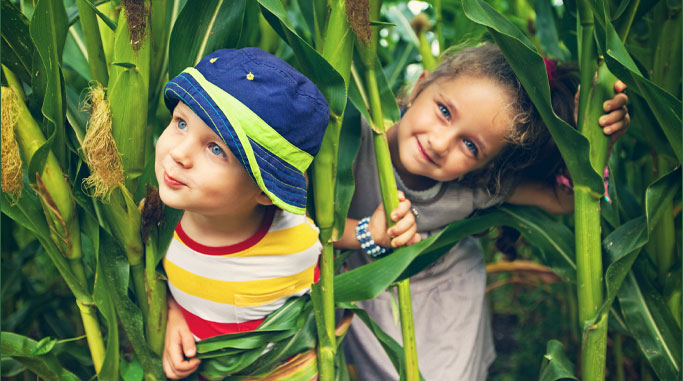





 Gardens Alive! & Supplies
Gardens Alive! & Supplies






